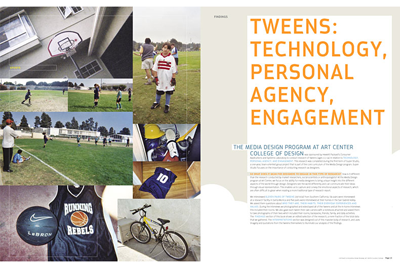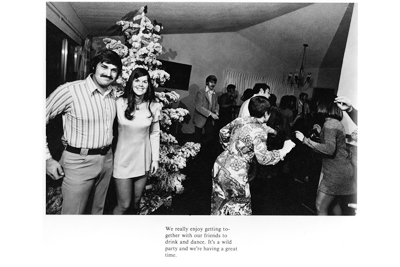Thesis:
Human Centered
Design Research:
Inspiration and empathy
 The Tween book competed by the Mobo class.
The Tween book competed by the Mobo class.Human centered design research--that is research that is focused on people--is conducted for a variety of reasons. Organizations like Cheskin conduct research for companies to understand market positions and to make marketing decisions. Cheskin primarily uses ethnographers to do their work with only a few designers working for them. IDEO builds multi-disciplinary teams of product designers, engineers, ethnographers, and researchers to investigate users; their goal is technical or interface innovations. Sean Donahue--for his thesis in the program--conducted HCDR in order to create an intervention for the specific users group he was investigating. The Tween Super Studio class designed a book of tools for exploring a specific space in the tween world they had discovered. The book was a deliverable to HP (who funded the class) and was meant to be used by engineers, senior management, and marketing. Their goal was to inspire others and create open-ended tools for creative outcomes.
The outcomes and audience that researchers are moving toward define the form their research take. When Cheskin seeks solid facts that can be distilled into summaries, it is different than when IDEO looks at users and a system to create new system requirements, which is different than seeking inspiration from and empathy to, a user group. Information, inspiration, and empathy are different goals, all sought under the umbrella of human centered design research.
My own goals in HCDR are varied. I believe in looking at others to be inspired, to empathize with them, and to design for their real needs or dreams--as opposed to the designer's assumptions about them. As Nugent and Gaver have said the process should be a conversation between the researchers and the participants, with room for ambiguity, interpretation, and the designers own voice.
 The photographer Bill Owens explored the emergence
The photographer Bill Owens explored the emergence of suburban culture in his book Suburbia.
An aspect of this thesis project was to test if it would be possible to conduct HCDR in which the outcomes would be for others to use. Tuuli Mattelmäki, among others, has conducted research like this, but she has worked in close relationship with the final users of the research. What I wished to explore is: could the research be done for a broad group like "video game designers," and could the outcome be a mass communication tool like a book or website (as opposed to a presentation, workshops, or private report.)